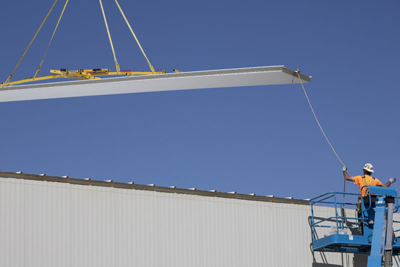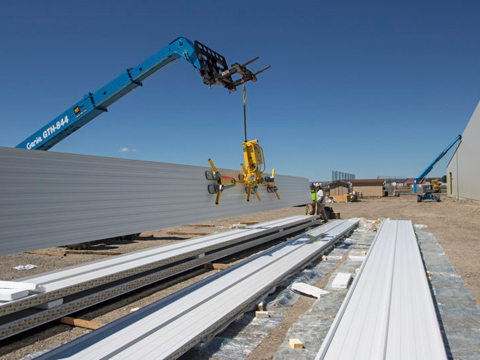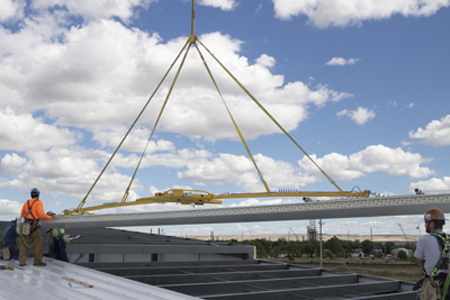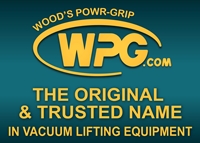Safer And More Efficient Handling Of Insulated Metal Panels
 By Dan Page, Wood's Powr-Grip Co. Inc.
By Dan Page, Wood's Powr-Grip Co. Inc.
The benefits of using lifting equipment to handle insulated metal panels (IMPs) are abundant, and IMP installers who have employed lifters can point to a range of reasons why to use the machines.
Using a lifter allows an installation crew to access the edges and opposite sides of the panel. More importantly, lifter use eliminates the need to make attachment modifications to the material, such as clamping or drilling holes. The negative result
could be delamination or other panel damage, not to mention the possibility of an unsightly finish if the drill hole locations weren’t properly determined.
Mostly, lifter use saves time and money, enhances personal safety and minimizes risk of damage to materials. For example, removing individual panels from shipped bundles without a lifter limits a crew’s options. Manually, to hoist a bulky, heavy
panel even slightly for the purposes of attaching slings or placing onto a forklift requires extra personnel and increases the chances of injury or panel damage.
What follows is how using a lifter specifically impacts a couple of IMP-handling tasks.
 Flipping Roof Panels
Flipping Roof Panels
To economically ship IMP roof panels, most manufacturers invert every other panel. A tilt-capable lifter makes it easier to flip inverted panels when removing them from the bundles. Tilting the load upright (male side up, female side down) allows crewmembers
to set an inverted panel on its edge temporarily before landing it face-up on another surface. Again, this is a labor-saving benefit of the lifter.
“Flipping these 500-pound panels would be a four-man job, and with the cladding lifter it was a two-man job,” says Brookes Reierson of Apex Steel Inc., Kirkland, WA. Reierson says that the lifter would have paid for itself in the number of
man hours Apex saved by using the lifter on a 17,500 sq. ft. construction project in 2015.
 Installing Roof Panels
Installing Roof Panels
Employing lifters diminishes risks and quickens completion times for a crew installing either standing seam panels or high-rib panels.
Manufacturers offer a range of lifter models and components engineered for specific jobs. For example, longer roof panels are handled better with lifters that have extensions to allow more pads (or more distance between pads) to attach to a panel, from
one end to the other, reducing the amount of overhang and putting less stress on the material.
When lifting or moving panels with slings, panels are more likely to be damaged; for example, by a sling being removed prematurely. Conversely, lifter use reduces this damage risk. Achieving the correct pitch for roof panel installation is not only possible,
but also easier when using a lifter. By slightly adjusting the attachment point, the hang of the panel can match the pitch.
Also, when a panel is ready to be placed by a lifter, there are no slings that crew members would need to remove immediately beforehand. Depending of the type of lifter used, the tilt function can be used to maneuver a standing seam panel to lock it in
place with an already placed panel without having to adjust the pitch.
Finally, there are situations in which lifter use is not recommended. Examples include use in excessively hot or cold temperatures, use at higher elevations, or use in wet conditions. Make sure to consult with a manufacturer or authorized dealer to determine
if a lifter is right for the job, and always read and understand the lifter’s instructions manual before using.
The author, Dan Page, is a staff writer with Wood’s Powr-Grip Co. Inc.
About Wood's Powr-Grip
 Wood's Powr-Grip Inc. designs, manufactures and distributes tools and equipment that improve efficiency, enhance
safety, and lower costs for the industries that it serves. The company offers a full line of hand-held vacuum cups, below-the-hook vacuum lifters and vacuum mounting cups that make material handling and equipment mounting easier. The products are
used to lift, hold and position a variety of smooth, nonporous materials such as insulated metal panels, glass, plastics, engine valves, sheet metal, solid surfacing, laminates, stone slabs and appliances. Powr-Grip products are individually tested
before being shipped from the production facility, in order to ensure quality and promote safety for the user.
Wood's Powr-Grip Inc. designs, manufactures and distributes tools and equipment that improve efficiency, enhance
safety, and lower costs for the industries that it serves. The company offers a full line of hand-held vacuum cups, below-the-hook vacuum lifters and vacuum mounting cups that make material handling and equipment mounting easier. The products are
used to lift, hold and position a variety of smooth, nonporous materials such as insulated metal panels, glass, plastics, engine valves, sheet metal, solid surfacing, laminates, stone slabs and appliances. Powr-Grip products are individually tested
before being shipped from the production facility, in order to ensure quality and promote safety for the user.
Wood's Powr-Grip's headquarters are located in Laurel, MT, and its vacuum cups and equipment products are distributed internationally in nearly 50 countries through an extensive network of dealers and distributors. For more information, visit www.wpg.com.




